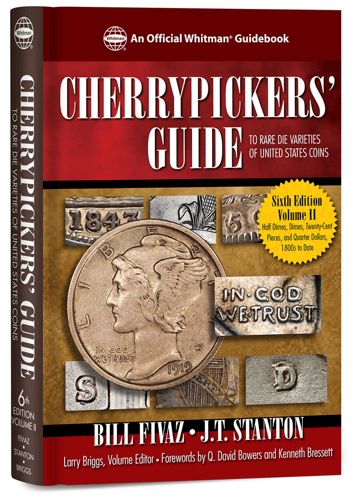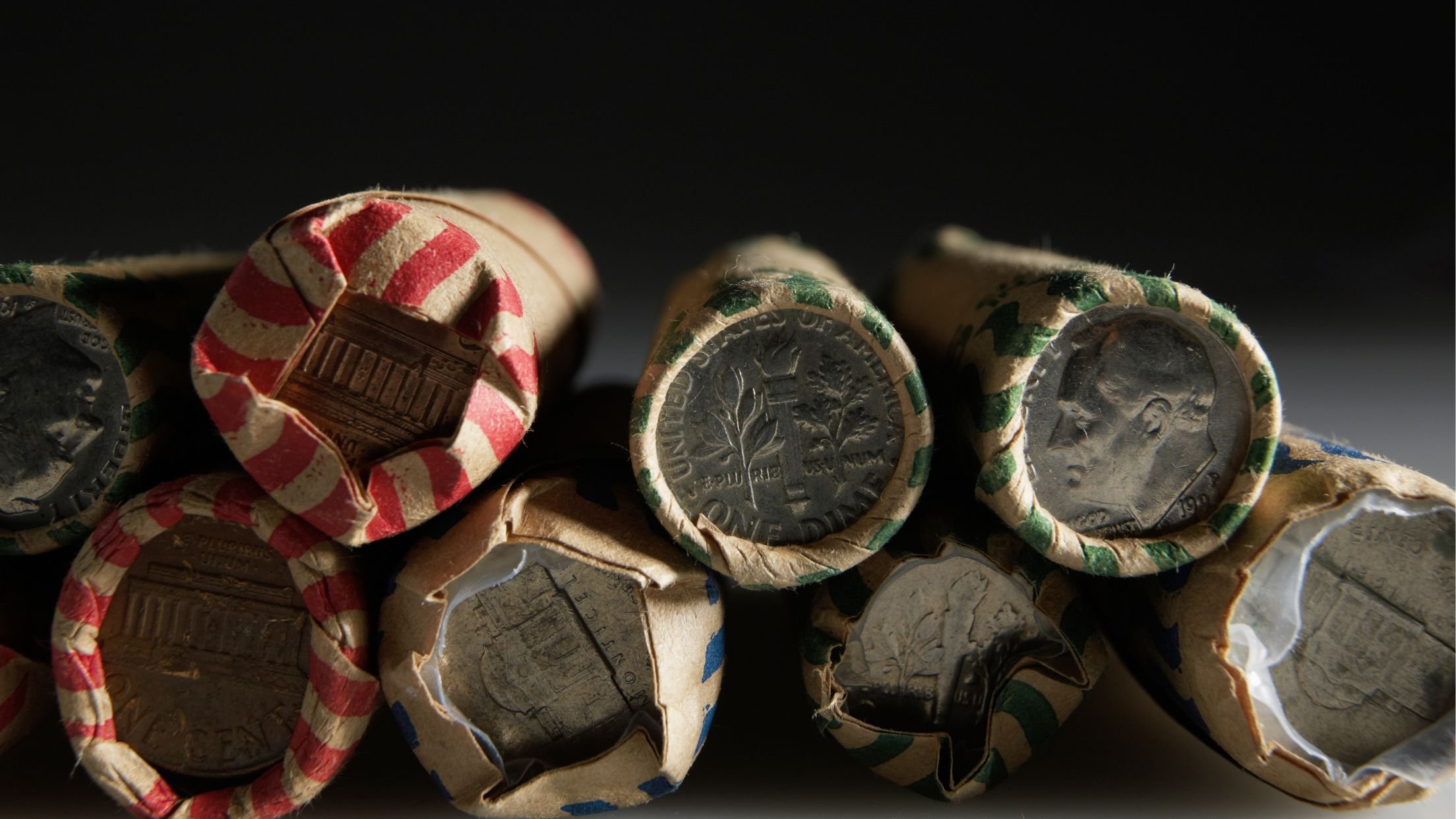Collecting Friends: Cherrypicking
Steve: I just picked up Whitman’s newly published Cherrypickers’ Guide to Rare Die Varieties, Volume II, and it’s wild to think that it’s been 33 years since J.T. Stanton and Bill Fivaz published the first Cherrypicker’s Guide. Now, before you correct me, Dennis, the version from 1990 on my desk has the apostrophe this way in the title, while later versions say Cherrypickers’.  It speaks to the humor of both authors when Bill and J.T. wrote, “A wise man once said: ‘A successful marriage requires falling in love many times, always with the same person,” before thanking their wives for their support through the original project.
It speaks to the humor of both authors when Bill and J.T. wrote, “A wise man once said: ‘A successful marriage requires falling in love many times, always with the same person,” before thanking their wives for their support through the original project.
J.T. has since passed away, and the volume starts with a dedication to the researcher, writer, dealer, teacher and hobby ambassador. While J.T. would say his initials stood for “Just Terrific,” it was actually Jeffrey Thomas and he taught a generation of collectors all about die varieties at the Summer Seminar. Bill served as a consultant on the new edition, supporting dealer Larry Briggs in his role as Volume Editor. It covers half dimes through quarter dollars and the forthcoming Volume III will have half dollars and silver dollars, gold coins, classic commemoratives, bullion and U.S. Philippines coins.
I have fond memories of searching through the first edition of the Cherrypicker’s Guide, hoping that I’d find a 1829 “Curl Base 2” Capped Bust dime (then FS-10c-001) where the second digit in the date has a curve to the base, rather than the usually seen flat base. Now it is listed as FS-10-1829-301 using the most recent numbering system. It’s always popular since it can be easily detected without a magnifying glass and is listed in the “Red Book.”
The varieties listed in the current Cherrypickers’ Guide ebb and flow based on demand. Dennis mentioned that more than two dozen Barber dimes were deleted from the fifth edition due to a lack of collector interest, replaced by some new ones, and gold varieties are getting more attention. Part of the fun of cherrypicking is that one presumably can find unattributed coins listed in Cherrypickers’ and then sell them for a profit, so the demand side has to be there for that equation to work.
The biggest surprise in the book was the inclusion of a counterfeit 1924-S Standing Liberty quarter dollar that shows an S/S/S “repunched” Mint mark that was included for educational purposes. I imagine a few collectors have been supremely disappointed in discovering this one, only to find it false.
My own experiences in cherrypicking have been moderate, finding an example of the primary 1972 doubled die obverse Lincoln, Memorial cent once in change along with the main 1974-D doubled die obverse Kennedy half dollar in a Mint set.
Dennis, have you ever cherrypicked a rare variety?
Dennis: I was going to jokingly say that the book was first called the Cherrypicker’s guide “because there was only one person cherrypicking back in those days”—but we know there were at least two (J.T. and Bill)! The die-variety niche had been trying to coalesce for a while before they published that first edition. Collectors just needed a good, solid reference book to get excited about and rally around. Bill and J.T. led the cherrypicking charge, and many more hobbyists have since followed.
I’ve tried my hand at cherrypicking—not so much with dealers’ inventories, but in circulation and by looking through bank rolls and coins from the U.S. Mint..png?width=360&height=389&name=coin%20rolls%20(1).png) These days I don’t check every coin I get in change (simply because I now need reading glasses, and they’re not always handy!), but I do look through most of them. I make an effort to pay with cash as often as possible, so I always have new circulating coins to examine.
These days I don’t check every coin I get in change (simply because I now need reading glasses, and they’re not always handy!), but I do look through most of them. I make an effort to pay with cash as often as possible, so I always have new circulating coins to examine.
It’s been a while since I hit up my bank for rolls of coins to search, but now that we’re talking about it I feel like I’ll be hounding the local tellers before too long. I used to get rolls of Kennedy half dollars because you can cherrypick for die varieties and, at the same time, try to get lucky and strike silver from the 1960s or earlier. No doubled dies or missing designer’s initials for me, but over the years I’ve found some silver halves and at least one misspent Proof.
Lately I’ve been ordering current coins directly from the Mint, through its subscription programs—rolls and bags of Native American dollars, American Women quarters, etc. I know these coins will almost certainly never be worth more than face value. But there’s always that outside chance of finding a new and amazing and valuable die variety. That’s what cherrypicking is all about!
I do remember one unusual find. Back in 1989, everyone was checking their Washington quarters because some of that year’s coins were struck without a mintmark. I found one in change that had its mintmark, but was struck 45 degrees out of normal die orientation. This discovery earned me a little write-up in Numismatic News, courtesy of Alan Herbert. It wasn’t a die variety, as such, but a rotated-die error.
I know from that experience that cool coins are out there, waiting to be found—if you look for them.

Be on the lookout for another installment of Collecting Friends next month or subscribe here and never miss a post! In the meantime, explore beautiful coins from the ANA's Edward C. Rochette Money Museum Virtual Exhibits.
About the Collecting Friends Blog
Hello! And welcome to the ANA’s blog series, “Collecting Friends.”
We decided to approach this much like a conversation between friends. One of us starts with a topic, then the other responds. Simple as that. Along those lines, we’ll keep the tone conversational as much as possible.
We both write about coins professionally, and will keep our relative style guides in our writing. For Dennis, Publisher at Whitman Publishing, that means capitalizing “Proof” and italicizing Red Book and never saying anything bad about Ken Bressett, who’s awesome anyway.
For Steve, who’s written with Coin World for 15 years, it means Winged Liberty Head dime instead of “Mercury” dime, and similar nuances and oddities. And, it means writing A Guide Book of United States Coins (better known as the “Red Book”).
Both of us started collecting when we were little, introduced to coins by a chance encounter with an old coin that sparked our curiosity. One of Steve’s interests is coin valuation, and he gravitates towards the intersection of art and coins. Dennis enjoys medals and world coins, and studying modern U.S. coins in the context of older series, what came before.
We met in 2012 at the American Numismatic Association World’s Fair of Money in Philadelphia at an event hosted by the Austrian Mint where there was both a Ben Franklin and a Betsy Ross impersonator. We’ve become great friends in the past decade. We even were appointed together to sit on the Citizens Coinage Advisory Committee starting in 2016, but Steve resigned soon after he was appointed to accept a full-time job at the Treasury Department while Dennis was re-appointed in 2020.
We taught a course together on numismatic publishing and writing a few years ago at the Summer Seminar, and while life has gotten in the way of us teaching another class, we jumped at our friend Caleb’s suggestion that we write a column. We hope you enjoy it!
.png?width=300&height=300&name=steve%20roach%20circle%20frame%20(2).png)
.png?width=300&height=300&name=dennis%20tucker%20circle%20frame%20(2).png)
About the American Numismatic Association
The American Numismatic Association is a nonprofit organization dedicated to educating and encouraging people to study and collect coins and related items. The Association serves collectors, the general public, and academic communities with an interest in numismatics.
The ANA helps all people discover and explore the world of money through its vast array of educational programs including its museum, library, publications, conventions and numismatic seminars.

.jpg)